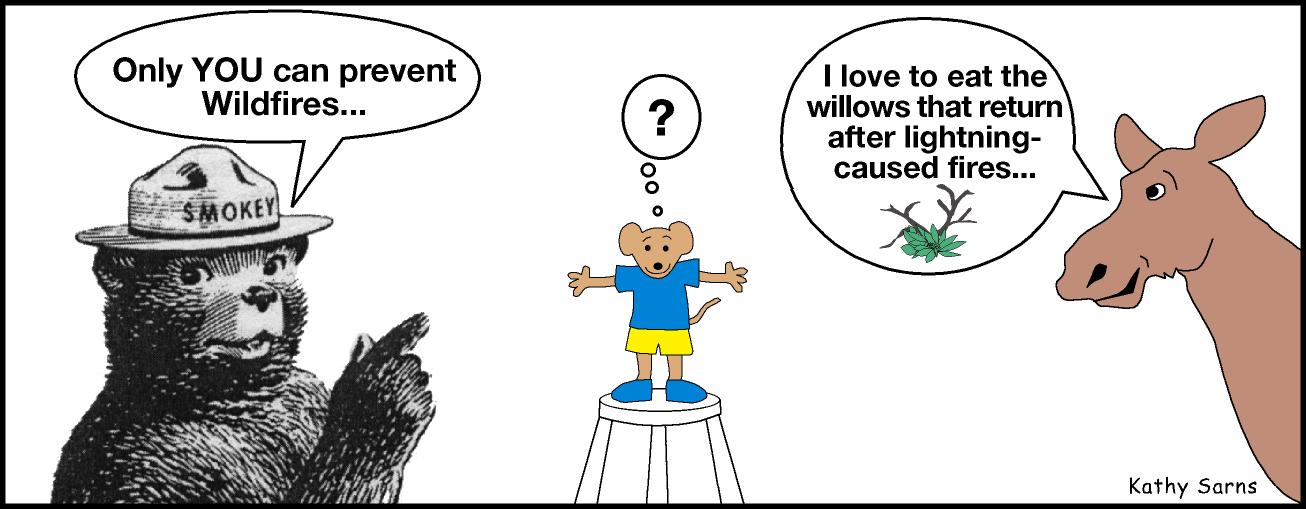
|
 |

| Grade Level: 6-12 |
| Alaska State Content Standards: LD1, LD2, LD4, LE2, GeoE4, GeoE5, GeoE6, GeoF3, GovG3 |
| Subject: Language Arts, Geography, Government |
| Skills: Comparison, Description, Evaluation, Generalization, Problem-Solving, Research |
| Duration: 2-3 class periods |
| Group Size: 4-6 |
| Setting: indoors |
OBJECTIVE
Students discuss current fire management issues and the importance of making informed management decisions.
TEACHING STRATEGY
Students express original opinions on fire management issues and then make informed decisions.
MATERIALS
Paper and markers
Index cards – 4 per student
Forest and Tundra Dilemma Background Information
![]() Sheet 1
Sheet 1
![]() Sheet 2
Sheet 2
![]() Sheet 3
Sheet 3
Reference materials including newspaper and magazine articles
TEACHER BACKGROUND
The following dilemmas are designed to help students identify different types of human perspectives related to fire management issues. They will then formulate opinions about what they think would be the most responsible and appropriate actions to take. There are no "right" or "wrong" answers. Teachers are encouraged to have students do additional research so that decisions are based on the best factual information available
PROCEDURE
Part A. The Original Options
- Give each student a magic marker and four index cards. Write a number on each card (1-4) corresponding to the opinions listed below. On the board write the following information: Opinions:
- Divide the class into groups of 4-6 students. Explain to students that one member of each group will be reading aloud the 3 resource management dilemmas.
- Each group reader will read aloud each dilemma to the group. Instruct students to think about the dilemma and choose an "opinion number" corresponding to their original opinion. When the group is ready, have students hold up their index cards with the number facing the reader. The group reader asks each student why they chose the opinion they did. For each dilemma, tally the results on paper making bar graphs representing the group’s original opinion for each dilemma.
1. definite NO
2. uncertain NO
3. uncertain YES
4. definite YES
- The intentional, planned use of fire to alter habitat is known as prescribed burning. Resource managers will prescribe burn an area to reduce a build-up of fire fuels or to maintain vegetation to benefit wildlife. Should prescribed fires be started or should nature be allowed to take its course?
- Spruce bark beetles kill thousands of trees on public forest land. The intentional, planned use of fire to alter habitat is known as prescribed burning. Should the government do prescribed burning in an attempt to stop the spread of the beetles?
- Some areas in SW Alaska should be categorized as limited action areas where fires are mainly monitored but not fought. The people who live a subsistence lifestyle in this area are very dependent on caribou herds that prefer the lichens that are destroyed by hot fires. Should another level of protection be given those areas to help maintain the reindeer herds that these people are so dependent upon?
- Give each group member a copy of the Dilemma Background Information Sheets and reference materials for the dilemmas. You may want to give each group only one dilemma to work on.
- Groups are to read their Dilemma Background Information Sheets. Students may further research newspaper and magazine articles or talk to local experts and agency people. After considering all the information and sides of the issue, the group will then formulate an informed group decision.
- Each group presents their findings and their informed decision to the class. The class is encouraged to ask questions. After each group's presentation, each student in the class makes their own informed decision about the dilemma. Students hold up an index card containing the number corresponding to their decision. The class informed decision is tallied and a new bar graph may be drawn.
Compare the original opinions and informed decisions. Discuss the importance of learning about all sides of an issue before making a decision or forming an opinion. Opinions and decisions are based on available information, which may or may not be complete or accurate. In addition, the media's presentation of an issue may or may not be biased. How can the public get the information they need to make researched decisions?
EVALUATION
Have students write a dilemma of their own, research it, and make an informed decision.
EXTENSION
Rather than researching each dilemma, informed decisions may be formulated after the class
has completed some of the other activities in this curriculum, including "Tundra or Boreal Forest Fire Hunt," or "Good or Bad Effects of Fire in the Tundra or Forest -- Who's To Say". Before each of these activities, read the dilemma and take an original opinion vote. Teachers may wish to substitute other dilemmas for those described here.
| Printable version | Add to favorites | Make Alaska FWS my homepage |
| Site designed and maintained jointly by the USFWS Alaska Region Division of Information Resource Management (IRM) and External Affairs (EA). |